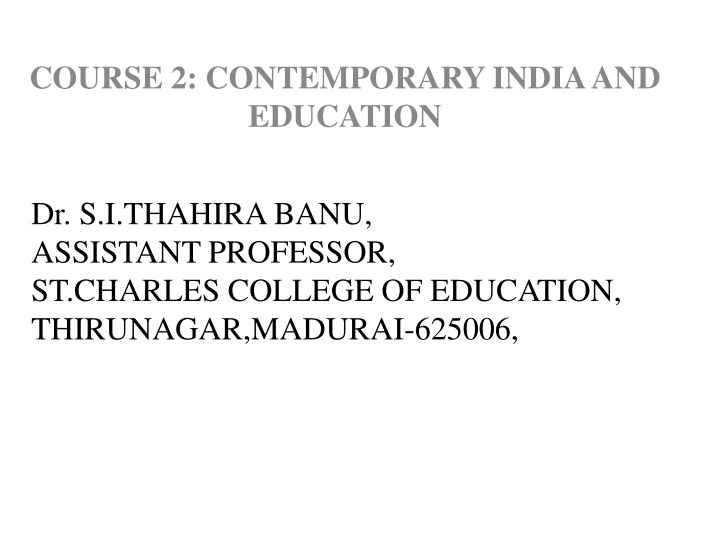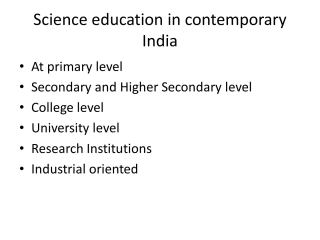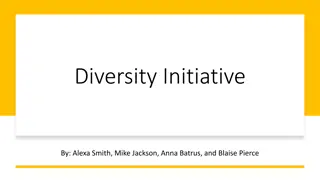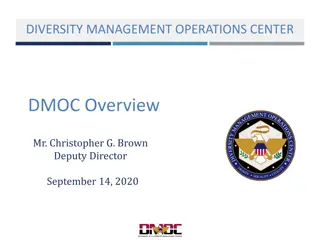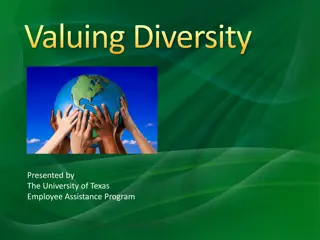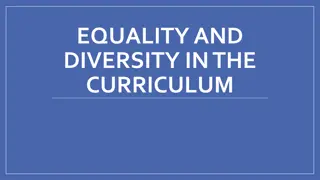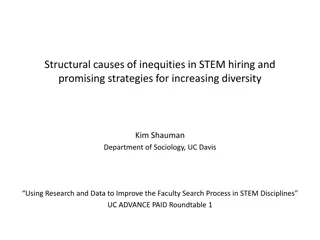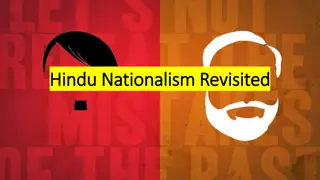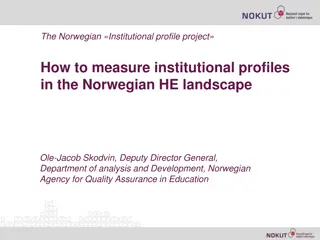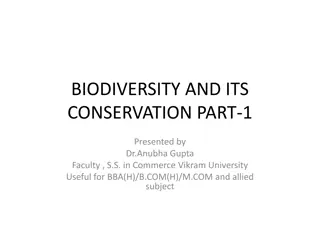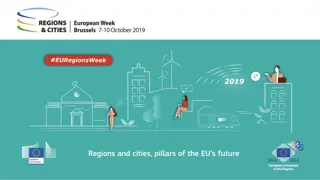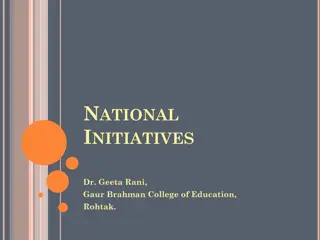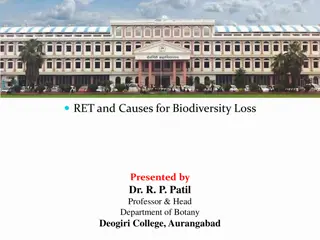Contemporary India and Education: Social Diversity Levels and Causes
Social diversity in India encompasses factors like race, culture, religion, age, and disabilities, with various levels including individual, regional, linguistic, religious, caste, and tribes diversity. The causes of regional and linguistic diversity stem from geographical, historical, political, psychological, social, and economic factors. Educational demands for diverse communities are addressed through initiatives like universalization of elementary education, emphasizing inclusivity and meeting the objectives of programs like SSA, RMSA, and RUSA.
Uploaded on Apr 04, 2025 | 1 Views
Download Presentation

Please find below an Image/Link to download the presentation.
The content on the website is provided AS IS for your information and personal use only. It may not be sold, licensed, or shared on other websites without obtaining consent from the author.If you encounter any issues during the download, it is possible that the publisher has removed the file from their server.
You are allowed to download the files provided on this website for personal or commercial use, subject to the condition that they are used lawfully. All files are the property of their respective owners.
The content on the website is provided AS IS for your information and personal use only. It may not be sold, licensed, or shared on other websites without obtaining consent from the author.
E N D
Presentation Transcript
COURSE 2: CONTEMPORARY INDIA AND EDUCATION Dr. S.I.THAHIRA BANU, ASSISTANT PROFESSOR, ST.CHARLES COLLEGE OF EDUCATION, THIRUNAGAR,MADURAI-625006,
COURSE 2: CONTEMPORARY INDIA AND EDUCATION Unit - I Understanding the Social Diversity 1. The concept of social diversity. 2. Different levels of social diversity. 3. Causes of social diversity.
Definition: Social diversity is the diverse factors surrounding our society such as race, culture, religion, age and disabilities. Levels of Social Diversity The levels of social diversity are: 1) Individual diversity, 2) Regional diversity, 3) Linguistic diversity, 4) Religious diversity, 5) Caste diversity, 6) Tribes diversity.
Causes of Regional Diversity (i) Geographical Causes (ii) Historical Causes (iii) Political Causes (iv) Psychological Causes (v) Social Causes (vi) Economic Causes.
3. Causes of Linguistic Diversity (i) Psychological Causes (ii)Historical Causes (iii)Geographical Causes (iv) Economic Causes (v) Political Causes (vi) Social Causes.
Unit-II: Educational Demands of Individuals and Diverse Communities 1. The need for universalization of elementary education(UEE) in India. 2. The objectives of SSA, RMSAand RUSA. 3. Concept of integrated education for inclusive education.
Universalization of Elementary Education(UEE) in India Article 45 of the Indian Constitution directed that "The State shall endeavor to provide within a period of ten years from the commencement of this constitution for free and compulsory education for all children until they complete the age of fourteen years."
Universalization of Elementary Education implies the following five aspects: (i) Universalization of provision, (ii) Universalization of enrolment , (iii) Universalization of retention, (iv) Universalization of participation, and (v) Universalization of achievement.
Programmes to achieve Universalisation of Education (A)Sarva ShikshaAbhiyan (SSA) The main mission of SSA is to provide "useful and relevant elementary education for all children in the 6 to 14 age group by 2010". SSA means to remove all social, regional and gender disparities in the education system through the active participation of the community. Main Features of SSA, Aims of SSA, Objectives of SSA.
(B) Rashtriya Madhayamik Shiksha Abiyan (RMSA) The Rashtriya Madhyamik (RMSA) is a flagship scheme of Government of India, launched in 2009 to enhance access to secondary education and improve its quality. The Ministry for Human Resource Development (MHRD) has brought out a Framework of Implementation of Rashtriya Madhyamik ShikshaAbhiyaan . Objectives of RMSA, Challenges in achieving Secondary Education. Shiksha Abhiyan
(C) Rashtriya (RUSA) The project was launched on 8th June 2013, it was implemented by MHRD as a centrally sponsored scheme with matching contribution from the State Government and Union Territories. It is proposed to set eligibility criteria for States to achieve a high and sustained impact of the project through monitoring and evaluation. The primary responsibility of the monitoring will lie with the institution themselves. The State Government and the Center through The Project Appraisal Board will monitor the project annually. Uchatar Shiksha Abhiyaan
Integrated Education Integration traditionally refers to the education of children with mainstream settings. Integrated education emphasizes methods which concentrate on viewing the student as a whole person. Every part of the individual - mind, body, emotion and spirit, should be developed at the same time and be integrated into the whole person. special needs in
Inclusive Education For inclusive education, special planning can be done in mainstream education like special infrastructure, specially designed classes, and special curriculum. Children with some special need can be made to sit in different classes or same classes with catering their needs. For example, hearing impaired children can be provided with audio aids for hearing. Visually impaired children can be provided with books in Braille.
Delors Commission Report: a) Education for Collective and Peaceful Living Education is declared to be the principle means available to foster a deeper and more harmonious from the human development and thereby to reduce poverty, exclusion, ignorance, oppression and war. The report observes that education throughout life is based on the following four pillars: a) Learning to know, b) Learning to do, c) Learning to live together, and d) Learning to be.
Unit - III Indian Constitutional Values on Education 1. The significance of Indian constitutional values on education. 2. Recognize the fundamental rights and duties of a citizen. 3. Implications of Directive Principle of State Policy on education. 4. Provisions of Right to EducationAct (RTE).
Fundamental Rights of Indian Citizens 1. Right to equality. 2. Right to freedom of speech and expression. 3. Right to freedom of religion. 4. Right against exploitation. 5. Right to life. 6. Cultural and educational rights. 7. Right to constitutional remedies.
Right to EducationAct (RTE)(2009) The Right of Children to Free and Compulsory Education Act or Right to Education Act also known as RTE, is an Act of the Parliament of India enacted on 4th August 2009, which describes the modalities of the importance of free and compulsory education for children between 6 and 14 in India under Article 21A of the Indian Constitution. a) Implementation and funding of RTE b) Status of Implementation of RTE.
Unit-IV Inequality, Discrimination and Marginalization in Education 1.The concept of discrimination and marginalization. 2. The different types of social inequality. 3. The causes of social inequality, discrimination and marginalization. 4. The importance of education to eliminate the social inequalities. 5. The means for inclusion of marginalized groups in education. social inequality,
Types of Social Inequality (i) Gender inequality inequality (iii) Caste inequality. Marginalized Society Marginalized groups are generally used to analyse socio-economic, political, and cultural spheres, where disadvantaged people struggle to gain access to resources and full participation in social life. In other words, marginalized people might be socially, economically, politically and legally ignored, excluded, or neglected, and, therefore vulnerable. Marginality is demeaning, for economic well-being, for human dignity, as well as for physical security. (ii) Racial and Ethnic
Unit-V Policy Framework on Education: Pre- Independent India 1. The education system of Vedic period. 2. The development of education the British rule. 3.The educational contributions of Christian Missionaries. 4.The major recommendations Commission. 5.The major recommendations of Abott Wood Report. of Hunter
(1)Education during Vedic Period The education system which was evolved first in ancient India is known as the Vedic system of education. In other words, the ancient system of education was based on the Vedas and therefore it was given the name of Vedic Educational System. a) Aims of Education b) Curriculum c) Methods of Instruction d) Role of Teacher e) Freedom and Discipline.
Buddhism and Education Lord Buddha, the founder of Buddhism did not write any book himself. His followers made the collection of his preaching 100 years after his death. The collection is known as Tripitikas . a) Aims of Education b) Curriculum c) Methods of Teaching d) Role of the Teacher. e) Freedom and Discipline. During this period, teachers played important role to help the Bhikshus (students) as stated below. (i) Developing Right Knowledge, (ii) Developing Right Will, (iii) Developing Right Speech, (iv) Developing Right Conduct, (v) Developing Right Memory, (vi) Developing Right means of Livelihood, and (vii) Developing Right Concentrations.
(3) Jainism and Education In the field of knowledge, Jaina philosophy is pluralist and relativist. Consciousness is the essence of the soul or Jiva. Knowledge according to Jaina system is of two kinds: Pramana and Nyya. Pramana is again of two kinds i.e., indirect and direct knowledge. Direct knowledge is gained by the means of the sense organs. Direct is valid in its own right. Direct knowledge is either practical or other worldly. Practical knowledge is achieved through mind and senses.
a).Aims of Education b) Curriculum c) Methods of Teaching d) Role of the Teacher. e) Freedom and Discipline. (4) Education during Mughal Period Muslim education system was essentially religious in character. Medieval period begins with the incoming of Muslims. So, this period also called Mohammedan Period . Mahmud Ghazani, Mohammed Ghauri, Qutab- ud-Din-Aibak, Iltutmish, Razia and Balban, Shahzada Mohammad, Khilji Kings, Tughlag Kings were the early Muslim famous kings. Muslim education received greater encouragement and attention during Mughal period. Babar, Humayan, Jahangir, Shahjahan, Dara Shikoh, Auragzeb, Bahadur Shah are the famous Mughal Kings. Shershahsuri, Akbar,
a).Aims of Education b) Curriculum c) Methods of Teaching d) Role of the Teacher. 5) Christian Missionaries Contributions to Education The Christians missionaries came to be associated with the educational enterprise in India. They established their center at Serampore. educational activities from Serampore. In 1725, the European Christian missionaries seventeen schools for the children of the Hindus and Muslims and four missionary schools of the Christians. In 1804, The London Missionaries society established English Schools in Ceylon Southern India and Bengal. The missionaries had rendered valuable service to the cause of education in India. They directed their had established
6) East India Companys Contributions to Education The East India Company s Charter of 1698 had directed the company to maintain schools of the kind called St. Mary s Charity schools was started in Madras in 1715. The officials of the East India Company also played important role for the spread of education. (i) Charter Act (1813) (ii) The Indian Education Commission (1882) (iii) The Government of India Resolution (1913) (iv) Hartog Committee (1929) (v) Wardha System of Education (1937) (vi)Abott -Wood Report (1936-37).
Unit VI Policy Framework on Education: Post- Independent India 1. The Kothari Commission (1964-66) 2. Iswar Bhai Patel Committee (1977) 3. Macolm S.Adiseshiah Committee (1978) 4. The recommendations of the NPE (1986). 5.. Features of NKC (2005). 6. The aspects of NCF (2005).
Kothari Commission (1964 1966) The Education Commission under the Chairmanship of Dr. D.S. Kothari, the then Chairman, University Grants Commission, began its task on October 2, 1964 and submitted its report on June 29 1966. The Commission observed that mother-tongue had a pre-eminent claim as the medium of education at the school and college levels. Moreover, the medium of education in school and higher education should generally be the same. The regional languages should, therefore, be adopted as the media of education in higher education.
Iswar Bhai Patel Committee (1977) With the passage of time, the Review Committee on the curriculum, for the ten years schooling, popularly known as Committee (1977), categorically recommended in its report for the compulsory introduction of Socially Useful Productive Work (SUPW) at the secondary schools. Ishwar Bhai Patel
Macolm S.Adiseshiah Committee (1978) In the year 1978, a Committee was appointed under the Chairmanship Adiseshiah for +2 stage and the report was entitled Learning to do, towards the Learning and Working socially. This Committee was appointed specially for higher secondary education with special vocationalisation. of Macolm S. reference to
Programme ofAction (POA)(1992) The National Policy on Education (NPE), 1986, aimed at making it "an effective instrument for taking the country into the 21st century". A modified NPE in its Programme of Action, 1992, called for making the `plus two stage" part of school education throughout the country.
Sachar Committee (2005) The Rajinder Sachar Committee, appointed by the Prime Minister Manmohan Singh of India was a high level committee for preparation of a report on the social, economic and educational status of the Muslim community of India. National Curriculum Framework (NCF) (2005) The process of development of National Curriculum Framework (NCF) was initiated in November, 2004 by setting up various structures like National Steering Committee Chaired by Prof. Yash Pal and twenty-one National themes of curricular areas, systemic reforms and national concerns. Focus Groups on
National Knowledge Commission (NKC)(2005) India constituted National knowledge Commission (NKC) in 2005, with transforming India into knowledge society. The NKC covers five focus areas of the knowledge paradigm: access, applications, and services. The scope of NKC is confined to a variety of subject areas such as language, translations, libraries, networks, portals, distance learning, entrepreneurship, application health, small and medium scale industries, e- governance, etc. the objective of concepts, creation, intellectual property, agriculture, in
Unit VII Educational Planning and Financing 1. The principles of educational financing. 2. The impact of five year plans on education. 3. The educational funding agencies.
Educational Planning Planning is the process of preparing a set of decisions for action during a specific period of time to achieve a set of goals. Educational Planning implies decisions for future action with a view to achieving predetermined objectives through the optimum use of scarce resources. Educational Planning is nothing more than a rational process of setting clear objectives, choosing the most efficient and effective means of pursuing them, then following with practical action. the taking of
Educational Financing Financing is defined as the act of providing funds for business activities, making purchases or investing. Financial institutions and banks are in the business of financing as they provide capital to businesses, consumers and investors to help them achieve their goals. Principles of Educational Financing Five Year Plans: Educational Policy making and Budgeting.
Unit VIII Language Policy in Education 1. Language policy during the pre-independent and post-independent India. 2. Language policy as specified in Indian constitution. 3. The views of great thinkers on medium instruction. of
Language spoken in India The first language education policy of India was made for the promotion of English language that is on February 2nd in 1835, Thomas Babington Macaulay s minute on Indian Language Policy was introduced. It says we must at present do our best to form a class who may be interpreters between us and the millions whom we govern .. We need a class of persons, let them Indian in blood and colour, but English in tastes, in opinions, in morals and in intellect .
Views of Great thinkers with respect to medium of instruction a) Rabindranath Tagore This paper probes the link between western approach to education in India and Tagore s educational view. The focus of this paper is on the thought of Rabindranath Tagore, especially in his educational ideas. Thus, this paper attempts to perceive the approaches and the values in two philosophies, education system from the West and East that is Tagore s. gigantic educational
b) M.K. Gandhi Education Policy as Envisaged by Mahatma Gandhi 1. Free and compulsory education for seven years on a nationwide scale. 2. The medium of instruction must be in mother tongue. 3. Throughout this period education should centre round some form of manual and productive work, and all other activities to be developed or training to be given should, as far as possible, be integrally related to handicraft pattern chosen with regard to the environment of the child. The
c) Swami Vivekananda The establishment of teacher education system in India is rooted in the history of modern education system for the masses established in the 19th century England and Europe to educate children in the three r s (reading, writing and arithmetic).
Unit IX Midday Meal Scheme as a Socialization Process 1.Meaning and concept Scheme. 2. The benefits of Midday Meal Scheme. 3. The process of Midday Meal Scheme in Tamil Nadu. of Midday Meal
Objectives of Midday Meal Scheme History of Midday Meals Scheme (MDMS) Benefits of Midday Meal Scheme Implications of MDMS on School Education MDMS as a Socialization Process Impact of MDMS in Tamil Nadu.
Unit X Emerging Trends in Education 1. The impact of globalization, privatization and liberalization. Globalization Concept of Globalization on Education Impact of Globalization on Education Liberalization Concept of Liberalization Privatization Concept of Privatization on Education Life Long Learning Concept of Life Long Learning Online Education Concept of Online Education.
